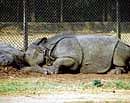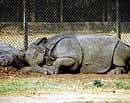
Ten years after the Sanjay Gandhi Zoological Park came into existence in Patna in 1969, a pair of rhino (Rhinocerous unicornis) - Kancha and Kanchi - was brought here from Guwahati. Three years later, or to be more precise - in 1982 - another rhino, Raju, was captured from Bettiah on Indo-Nepal border, and brought to the zoo.
Though the warm climate of Patna is not conducive for housing rhinos, Raju and Kanchi mated successfully and gave birth to a baby rhino after a long gestation period of 18 months. The year 1983 proved to be a turning point for the zoological park, as four more rhinos were born in successive years.
Three decades down the line, the Sanjay Gandhi Zoological Park here has six male and as many female rhinos. Today the zoo has second largest population of rhinos in the world.
“So far as the population of rhinos is concerned, the Patna zoo tops the list in India, and is second in the world after San Diego, (in US)” the zoo director Abhay Kumar told Deccan Herald, while dwelling at length on how there was a difference between a rhino breeding in Kaziranga (Assam) and one in the cage of a zoo.
Three cheers
“The year 2010 has witnessed successful mating of three female rhinos. So we are expecting three more ‘new guests’ next year,” said Kumar.
In view of the large number of rhinos, the problem of housing them is bound to arise. So he is now mulling over the proposal to set up a rhino safari, much on the lines of lion safari in Nandankanan (Orissa). “Once these rhinos grow up, it will be very difficult to keep them confined within a cage or a limited area. Chances are they might harm themselves by constantly clashing each other. So we have sent a proposal to the Central Zoo Authority (CZA) for setting up a rhino safari in the southern area for providing a good and natural congenial habitat to rhinos,” he added.
Endangered species
The Indian rhino is primarily found in Terrai regions (in the foothills of Himalayas). It is confined to tall grasslands in the Indo-Gangetic belt. But after poaching began, their numbers dwindled over the years. The Centre then declared it a Schedule 1 animal. Eventually, an ambitious project was launched in the country for the conservation of the endangered species. “This is precisely why the CZA has selected Patna zoo as a breeding centre for rhinos,” Kumar said, and added, “The Sanjay Gandhi Park came into limelight due to high breeding of rhinos. Now more countries want to know about the techniques used at the Patna zoo, the kind of food we give to the world's most endangered species, and the size of the cages.”
Earlier, under the mutual exchange programme carried out by the International Rhino Federation, two rhinos were transported from Patna to the US in exchange of three giraffes and two female rhinos from St Diego Wild Animal Park.
